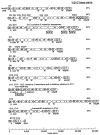Pseudomonas aeruginosa lipopolysaccharide: a major virulence factor, initiator of inflammation and target for effective immunity
- PMID: 17466590
- PMCID: PMC1994162
- DOI: 10.1016/j.ijmm.2007.03.012
Pseudomonas aeruginosa lipopolysaccharide: a major virulence factor, initiator of inflammation and target for effective immunity
Erratum in
- Int J Med Microbiol. 2007 Nov;297(7-8):641
Abstract
Pseudomonas aeruginosa is one of the most important bacterial pathogens encountered by immunocompromised hosts and patients with cystic fibrosis (CF), and the lipopolysaccharide (LPS) elaborated by this organism is a key factor in virulence as well as both innate and acquired host responses to infection. The molecule has a fair degree of heterogeneity in its lipid A and O-antigen structure, and elaborates two different outer-core glycoforms, of which only one is ligated to the O-antigen. A close relatedness between the chemical structures and genes encoding biosynthetic enzymes has been established, with 11 major O-antigen groups identified. The lipid A can be variably penta-, hexa- or hepta-acylated, and these isoforms have differing potencies when activating host innate immunity via binding to Toll-like receptor 4 (TLR4). The O-antigen is a major target for protective immunity as evidenced by numerous animal studies, but attempts, to date, to produce a human vaccine targeting these epitopes have not been successful. Newer strategies employing live attenuated P. aeruginosa, or heterologous attenuated bacteria expressing P. aeruginosa O-antigens are potential means to solve some of the existing problems related to making a P. aeruginosa LPS-specific vaccine. Overall, there is now a large amount of information available about the genes and enzymes needed to produce the P. aeruginosa LPS, detailed chemical structures have been determined for the major O-antigens, and significant biologic and immunologic studies have been conducted to define the role of this molecule in virulence and immunity to P. aeruginosa infection.
Figures




Similar articles
-
Pseudomonas aeruginosa antigens as potential vaccines.FEMS Microbiol Rev. 1997 Nov;21(3):243-77. doi: 10.1111/j.1574-6976.1997.tb00353.x. FEMS Microbiol Rev. 1997. PMID: 9451816 Review.
-
Review: Lipopolysaccharide biosynthesis in Pseudomonas aeruginosa.Innate Immun. 2009 Oct;15(5):261-312. doi: 10.1177/1753425909106436. Epub 2009 Aug 26. Innate Immun. 2009. PMID: 19710102 Review.
-
Pseudomonas aeruginosa lipid A diversity and its recognition by Toll-like receptor 4.J Endotoxin Res. 2003;9(6):395-400. doi: 10.1179/096805103225002764. J Endotoxin Res. 2003. PMID: 14733728
-
A Pseudomonas aeruginosa hepta-acylated lipid A variant associated with cystic fibrosis selectively activates human neutrophils.J Leukoc Biol. 2016 Nov;100(5):1047-1059. doi: 10.1189/jlb.4VMA0316-101R. Epub 2016 Aug 18. J Leukoc Biol. 2016. PMID: 27538572 Free PMC article.
-
Presence or absence of lipopolysaccharide O antigens affects type III secretion by Pseudomonas aeruginosa.J Bacteriol. 2007 Mar;189(6):2203-9. doi: 10.1128/JB.01839-06. Epub 2007 Jan 5. J Bacteriol. 2007. PMID: 17209027 Free PMC article.
Cited by
-
The Anti-Microbial Peptide (Lin-SB056-1)2-K Reduces Pro-Inflammatory Cytokine Release through Interaction with Pseudomonas aeruginosa Lipopolysaccharide.Antibiotics (Basel). 2020 Sep 8;9(9):585. doi: 10.3390/antibiotics9090585. Antibiotics (Basel). 2020. PMID: 32911618 Free PMC article.
-
Immune Sensing of Lipopolysaccharide in Plants and Animals: Same but Different.PLoS Pathog. 2016 Jun 9;12(6):e1005596. doi: 10.1371/journal.ppat.1005596. eCollection 2016 Jun. PLoS Pathog. 2016. PMID: 27281177 Free PMC article. Review. No abstract available.
-
Pseudomonas aeruginosa LPS or flagellin are sufficient to activate TLR-dependent signaling in murine alveolar macrophages and airway epithelial cells.PLoS One. 2009 Oct 6;4(10):e7259. doi: 10.1371/journal.pone.0007259. PLoS One. 2009. PMID: 19806220 Free PMC article.
-
Integrin αvβ6 mediates epithelial-mesenchymal transition in human bronchial epithelial cells induced by lipopolysaccharides of Pseudomonas aeruginosa via TGF-β1-Smad2/3 signaling pathway.Folia Microbiol (Praha). 2020 Apr;65(2):329-338. doi: 10.1007/s12223-019-00728-w. Epub 2019 Jun 26. Folia Microbiol (Praha). 2020. PMID: 31243731 Free PMC article.
-
Phenazines as potential biomarkers of Pseudomonas aeruginosa infections: synthesis regulation, pathogenesis and analytical methods for their detection.Anal Bioanal Chem. 2020 Sep;412(24):5897-5912. doi: 10.1007/s00216-020-02696-4. Epub 2020 May 27. Anal Bioanal Chem. 2020. PMID: 32462363 Review.
References
-
- Alexander JW, Fisher MW, MacMillan BG, Altemeier WA. Prevention of invasive Pseudomonas infection in burns with a new vaccine. Arch Surg. 1969;99:249–256. - PubMed
-
- Alexander JW, Fisher MW. Immunization against Pseudomonas infection after thermal injury. J Infect Dis. 1974;130:S152–S158. - PubMed
-
- Backhed F, Normark S, Schweda EKH, Oscarson S, Richter-Dahlfors A. Structural requirements for TLR4-mediated LPS signalling: a biological role for LPS modifications. Microbes Infect. 2003;5:1057–1063. - PubMed
Publication types
MeSH terms
Substances
Grants and funding
LinkOut - more resources
Full Text Sources
Other Literature Sources

